Fault Tolerance Framework using Model-Based - IARIA Journals
Fault Tolerance Framework using Model-Based - IARIA Journals
Fault Tolerance Framework using Model-Based - IARIA Journals
You also want an ePaper? Increase the reach of your titles
YUMPU automatically turns print PDFs into web optimized ePapers that Google loves.
International Journal on Advances in Security, vol 4 no 1 & 2, year 2011, http://www.iariajournals.org/security/<br />
of measures that promote the reduction of the risk of possible<br />
faults and increase the dependability of business processes<br />
from design stages. The majority of proposals have used<br />
fault tolerance ideas in other areas such as: firewalls, grid<br />
computing, composition of applications and service-oriented<br />
architectures, [9][10][11][12][13]. In these studies, various<br />
fault tolerance approaches have been applied: check-point<br />
view [9], replication and recovery techniques [10][11], and<br />
other sophisticated techniques such as dynamic binding [12],<br />
and self-reconfiguration of systems [13]. Our approach proposes<br />
to improve dependability properties in the execution<br />
of business processes based on techniques for automatic<br />
identification of faults by means of model-based diagnosis<br />
which helps to establish specific fault tolerance mechanisms.<br />
<strong>Fault</strong> tolerant mechanisms applied in this work are based<br />
on classic fault tolerance ideas such as replication, checkpointing<br />
and techniques of diversity focused on the context<br />
of service-oriented business processes.<br />
This paper is structured as follows: Section II introduces<br />
some concepts of BPM and fault tolerance; Section III<br />
presents our framework for dependable business processes<br />
<strong>using</strong> fault-tolerant techniques; in Section IV, a practical<br />
example is explained and developed; Section V shows experimental<br />
results that are discussed; and, in the last section,<br />
conclusions are drawn and future work is proposed.<br />
II. BUSINESS PROCESS MANAGEMENT SYSTEM AND<br />
FAULT TOLERANCE<br />
In order to understand the BPM paradigm, it is necessary to<br />
show the typical business process life cycle [5], as shown<br />
in Figure 1. The life cycle consists of different stages:<br />
1) Design and Analysis: business process models are<br />
defined and validated.<br />
2) Configuration: once business process models are validated,<br />
they need to be implemented by a dedicated<br />
software system. In this configuration stage a software<br />
systems (BPMS) is chosen and configured where business<br />
processes will be deployed.<br />
3) Enactment: once deployed, process enactment needs<br />
to guarantee correct execution in accordance with<br />
various constraints specified in the model.<br />
4) Diagnosis: techniques are applied to identify and<br />
isolate faults in business processes. Nowadays, most<br />
diagnosis techniques applied are focused on identifying<br />
design faults.<br />
In BPM, several levels of business processes can be<br />
identified depending on the point of view of the organization<br />
[4]. In this paper, only two levels of BPM are considered:<br />
• Operational business processes are described with business<br />
process models where the activities and their relationships<br />
are specified, but implementation aspects are<br />
not taken into account. Operational processes are the<br />
basis for developing implemented business processes.<br />
Figure 1. Business process life cycle.<br />
• Implemented business processes contain information<br />
about the execution of the activities and the technical<br />
and organizational environment where they will be<br />
deployed and executed.<br />
Implemented business processes and specifically servicebased<br />
business process use external services which remain<br />
outside the jurisdiction of the organization. Although, business<br />
process models are validated and verified at the design<br />
stage, organizations cannot guarantee the correct execution<br />
of changes in services interms of functionality and faults<br />
simply through the lack of response or security attacks, and<br />
so on. The identification of where business processes are<br />
failing, and which components are involved in the faults may<br />
probe worthwhile for the numerous business stakeholders<br />
(designers, analysts, developers, etc).<br />
<strong>Fault</strong> diagnosis is a method which permits us to determine<br />
why a correctly designed business process fail to work<br />
as expected. Diagnosis aims to identify and isolate the<br />
reason of any unexpected behaviour, or in other words, to<br />
identify which parts are failing in a business process. In this<br />
work, model-based diagnosis [14] is used in order to isolate<br />
the faulty services. <strong>Model</strong>-based diagnosis is recognized as<br />
a very powerful tool within the community of diagnosis<br />
due to its ability to solve the problem of isolating faulty<br />
components.<br />
Our proposal is focused on achieving dependable business<br />
processes, but to the achievement of dependability must first<br />
be clarified [15]. The properties for achieving dependability<br />
fall into four major groups: fault tolerance, fault avoidance<br />
or prevention, fault removal, and fault forecasting.<br />
By definition, fault tolerance [15] is a mechanism used<br />
to order to guarantee service by complying with the specification<br />
in spite of the presence of faults. <strong>Fault</strong>-tolerance<br />
techniques are a means of reducing the risk of faults. On the<br />
whole, fault-tolerance frameworks are focused on physical<br />
systems and not on software systems and most applied<br />
techniques are based on replication and recovery. Replication<br />
is employed in the recuperation of services by means of<br />
duplication of each of its functionalities in form of replicas<br />
2011, © Copyright by authors, Published under agreement with <strong>IARIA</strong> - www.iaria.org<br />
12







